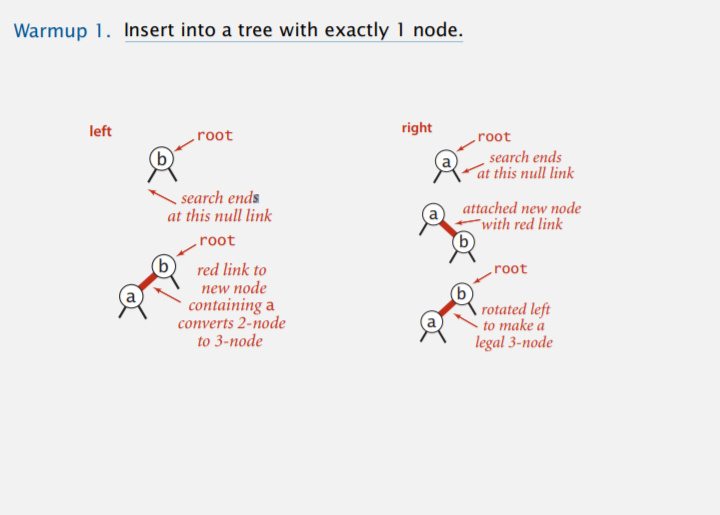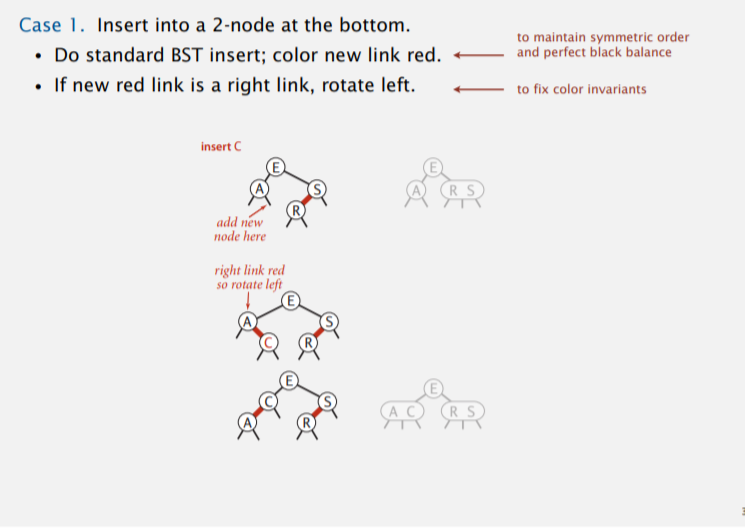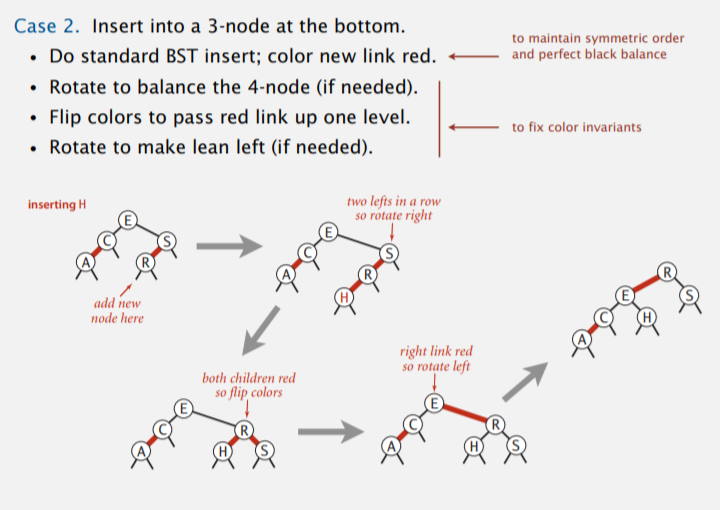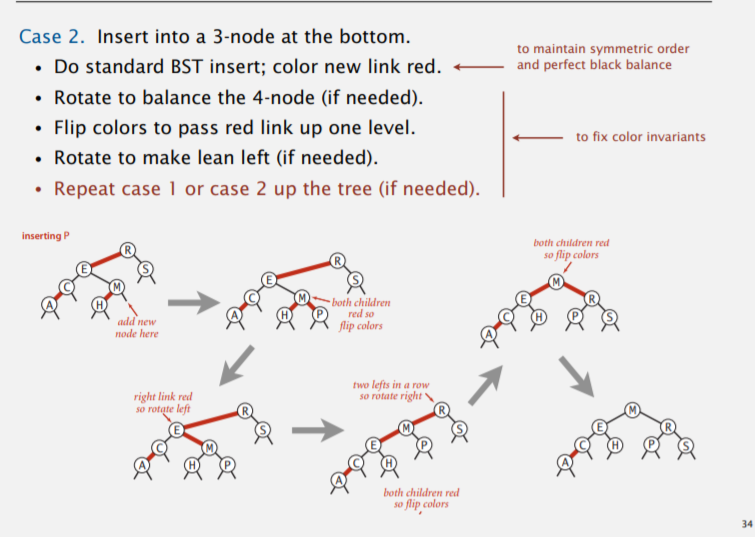# AVL
# 1 AVL 定义
- AVL树是最早被发明的自平衡二叉查找树。在AVL树中,任一节点对应的两棵子树的最大高度差为1,因此它也被称为高度平衡树。查找、插入和删除在平均和最坏情况下的时间复杂度都是 O(log {n} 。增加和删除元素的操作则可能需要借由一次或多次树旋转,以实现树的重新平衡.
# 2 2-3 serach tree
# 1 定义
Allow 1 or 2 keys per node.
・2-node: one key, two children.
・3-node: two keys, three children.
Symmetric order. Inorder traversal yields keys in ascending order.
Perfect balance. Every path from root to null link has same length.
# 2 操作
# 1 search
- ・Compare search key against keys in node.
- ・Find interval containing search key.
- ・Follow associated link (recursively).
# 2 Insertion
- insertion into a 3-node at bottom.
- ・Add new key to 3-node to create temporary 4-node.
- ・Move middle key in 4-node into parent.
- ・Repeat up the tree, as necessary.
- ・If you reach the root and it's a 4-node, split it into three 2-nodes
# 2 B-tree.
# 1 difene:
- Generalize 2-3 trees by allowing up to M - 1 key-link pairs per node.
- ・At least 2 key-link pairs at root.
- ・At least M / 2 key-link pairs in other nodes.
- ・External nodes contain client keys.
- ・Internal nodes contain copies of keys to guide search.
# 2 application
- 操作系统的文件系统
# 3 红黑BST
# 1 2-3tree实现 红黑BST
- Challenge. How to represent a 3 node?
- Approach :
- regular BST with red "glue" links.
- ・Widely used in practice.
- ・Arbitrary restriction: red links lean left
# 1 性质
- ・No node has two red links connected to it.
- ・Every path from root to null link has the same number of black links.
- ・Red links lean left.
# 2 操作
# 0 init
public class RedBlackBST<Key extends Comparable<Key>, Value> {
private static final boolean RED = true;
private static final boolean BLACK = false;
private Node root; // root of the BST
// BST helper node data type
private class Node {
private Key key; // key
private Value val; // associated data
private Node left, right; // links to left and right subtrees
private boolean color; // color of parent link
private int size; // subtree count
public Node(Key key, Value val, boolean color, int size) {
this.key = key;
this.val = val;
this.color = color;jav
this.size = size;
}
}
/**
* Initializes an empty symbol table.
*/
public RedBlackBST() {
}
/***************************************************************************
* Node helper methods.
***************************************************************************/
// is node x red; false if x is null ?
private boolean isRed(Node x) {
if (x == null) return false;
return x.color == RED;
}
}
# 1 get
public Value get(Key key) {
if (key == null) throw new IllegalArgumentException("argument to get() is null");
return get(root, key);
}
// value associated with the given key in subtree rooted at x; null if no such key
private Value get(Node x, Key key) {
while (x != null) {
int cmp = key.compareTo(x.key);
if (cmp < 0) x = x.left;
else if (cmp > 0) x = x.right;
else return x.val;
}
return null;
}
# 2 put
public void put(Key key, Value val) {
if (key == null)
throw new IllegalArgumentException("first argument to put() is null");
if (val == null) {
delete(key);
return;
}
root = put(root, key, val);
root.color = BLACK;
// assert check();
}
// insert the key-value pair in the subtree rooted at h
private Node put(Node h, Key key, Value val) {
if (h == null) return new Node(key, val, RED, 1);
int cmp = key.compareTo(h.key);
if (cmp < 0) h.left = put(h.left, key, val);
else if (cmp > 0) h.right = put(h.right, key, val);
else h.val = val;
// fix-up any right-leaning links
if (isRed(h.right) && !isRed(h.left)) h = rotateLeft(h);
if (isRed(h.left) && isRed(h.left.left)) h = rotateRight(h);
if (isRed(h.left) && isRed(h.right)) flipColors(h);
h.size = size(h.left) + size(h.right) + 1;
return h;
}
# 3 rotateLeft
private Node rotateLeft(Node h) {
// assert (h != null) && isRed(h.right);
Node x = h.right;
h.right = x.left;
x.left = h;
x.color = x.left.color;
x.left.color = RED;
x.size = h.size;
h.size = size(h.left) + size(h.right) + 1;
return x;
}
# 4 rotate right
private Node rotateRight(Node h) {
// assert (h != null) && isRed(h.left);
Node x = h.left;
h.left = x.right;
x.right = h;
x.color = x.right.color;
x.right.color = RED;
x.size = h.size;
h.size = size(h.left) + size(h.right) + 1;
return x;
}
# 5 flipColors
private void flipColors(Node h) {
// h must have opposite color of its two children
// assert (h != null) && (h.left != null) && (h.right != null);
// assert (!isRed(h) && isRed(h.left) && isRed(h.right))
// || (isRed(h) && !isRed(h.left) && !isRed(h.right));
h.color = !h.color;
h.left.color = !h.left.color;
h.right.color = !h.right.color;
}
# 3 insert 分析
# 1 Insert into a tree with exactly 1 node.

# 2 Insert into a tree with exactly 1 node.
# 
# 
# 3 Insert into a tree with exactly 3 node.


# 4 实现
public class RedBlackBST<Key extends Comparable<Key>, Value> {
private static final boolean RED = true;
private static final boolean BLACK = false;
private Node root; // root of the BST
// BST helper node data type
private class Node {
private Key key; // key
private Value val; // associated data
private Node left, right; // links to left and right subtrees
private boolean color; // color of parent link
private int size; // subtree count
public Node(Key key, Value val, boolean color, int size) {
this.key = key;
this.val = val;
this.color = color;
this.size = size;
}
}
/**
* Initializes an empty symbol table.
*/
public RedBlackBST() {
}
/***************************************************************************
* Node helper methods.
***************************************************************************/
// is node x red; false if x is null ?
private boolean isRed(Node x) {
if (x == null) return false;
return x.color == RED;
}
// number of node in subtree rooted at x; 0 if x is null
private int size(Node x) {
if (x == null) return 0;
return x.size;
}
/**
* Returns the number of key-value pairs in this symbol table.
* @return the number of key-value pairs in this symbol table
*/
public int size() {
return size(root);
}
/**
* Is this symbol table empty?
* @return {@code true} if this symbol table is empty and {@code false} otherwise
*/
public boolean isEmpty() {
return root == null;
}
/***************************************************************************
* Standard BST search.
***************************************************************************/
/**
* Returns the value associated with the given key.
* @param key the key
* @return the value associated with the given key if the key is in the symbol table
* and {@code null} if the key is not in the symbol table
* @throws IllegalArgumentException if {@code key} is {@code null}
*/
public Value get(Key key) {
if (key == null) throw new IllegalArgumentException("argument to get() is null");
return get(root, key);
}
// value associated with the given key in subtree rooted at x; null if no such key
private Value get(Node x, Key key) {
while (x != null) {
int cmp = key.compareTo(x.key);
if (cmp < 0) x = x.left;
else if (cmp > 0) x = x.right;
else return x.val;
}
return null;
}
/**
* Does this symbol table contain the given key?
* @param key the key
* @return {@code true} if this symbol table contains {@code key} and
* {@code false} otherwise
* @throws IllegalArgumentException if {@code key} is {@code null}
*/
public boolean contains(Key key) {
return get(key) != null;
}
/***************************************************************************
* Red-black tree insertion.
***************************************************************************/
/**
* Inserts the specified key-value pair into the symbol table, overwriting the old
* value with the new value if the symbol table already contains the specified key.
* Deletes the specified key (and its associated value) from this symbol table
* if the specified value is {@code null}.
*
* @param key the key
* @param val the value
* @throws IllegalArgumentException if {@code key} is {@code null}
*/
public void put(Key key, Value val) {
if (key == null) throw new IllegalArgumentException("first argument to put() is null");
if (val == null) {
delete(key);
return;
}
root = put(root, key, val);
root.color = BLACK;
// assert check();
}
// insert the key-value pair in the subtree rooted at h
private Node put(Node h, Key key, Value val) {
if (h == null) return new Node(key, val, RED, 1);
int cmp = key.compareTo(h.key);
if (cmp < 0) h.left = put(h.left, key, val);
else if (cmp > 0) h.right = put(h.right, key, val);
else h.val = val;
// fix-up any right-leaning links
if (isRed(h.right) && !isRed(h.left)) h = rotateLeft(h);
if (isRed(h.left) && isRed(h.left.left)) h = rotateRight(h);
if (isRed(h.left) && isRed(h.right)) flipColors(h);
h.size = size(h.left) + size(h.right) + 1;
return h;
}
/***************************************************************************
* Red-black tree deletion.
***************************************************************************/
/**
* Removes the smallest key and associated value from the symbol table.
* @throws NoSuchElementException if the symbol table is empty
*/
public void deleteMin() {
if (isEmpty()) throw new NoSuchElementException("BST underflow");
// if both children of root are black, set root to red
if (!isRed(root.left) && !isRed(root.right))
root.color = RED;
root = deleteMin(root);
if (!isEmpty()) root.color = BLACK;
// assert check();
}
// delete the key-value pair with the minimum key rooted at h
private Node deleteMin(Node h) {
if (h.left == null)
return null;
if (!isRed(h.left) && !isRed(h.left.left))
h = moveRedLeft(h);
h.left = deleteMin(h.left);
return balance(h);
}
/**
* Removes the largest key and associated value from the symbol table.
* @throws NoSuchElementException if the symbol table is empty
*/
public void deleteMax() {
if (isEmpty()) throw new NoSuchElementException("BST underflow");
// if both children of root are black, set root to red
if (!isRed(root.left) && !isRed(root.right))
root.color = RED;
root = deleteMax(root);
if (!isEmpty()) root.color = BLACK;
// assert check();
}
// delete the key-value pair with the maximum key rooted at h
private Node deleteMax(Node h) {
if (isRed(h.left))
h = rotateRight(h);
if (h.right == null)
return null;
if (!isRed(h.right) && !isRed(h.right.left))
h = moveRedRight(h);
h.right = deleteMax(h.right);
return balance(h);
}
/**
* Removes the specified key and its associated value from this symbol table
* (if the key is in this symbol table).
*
* @param key the key
* @throws IllegalArgumentException if {@code key} is {@code null}
*/
public void delete(Key key) {
if (key == null) throw new IllegalArgumentException("argument to delete() is null");
if (!contains(key)) return;
// if both children of root are black, set root to red
if (!isRed(root.left) && !isRed(root.right))
root.color = RED;
root = delete(root, key);
if (!isEmpty()) root.color = BLACK;
// assert check();
}
// delete the key-value pair with the given key rooted at h
private Node delete(Node h, Key key) {
// assert get(h, key) != null;
if (key.compareTo(h.key) < 0) {
if (!isRed(h.left) && !isRed(h.left.left))
h = moveRedLeft(h);
h.left = delete(h.left, key);
}
else {
if (isRed(h.left))
h = rotateRight(h);
if (key.compareTo(h.key) == 0 && (h.right == null))
return null;
if (!isRed(h.right) && !isRed(h.right.left))
h = moveRedRight(h);
if (key.compareTo(h.key) == 0) {
Node x = min(h.right);
h.key = x.key;
h.val = x.val;
// h.val = get(h.right, min(h.right).key);
// h.key = min(h.right).key;
h.right = deleteMin(h.right);
}
else h.right = delete(h.right, key);
}
return balance(h);
}
/***************************************************************************
* Red-black tree helper functions.
***************************************************************************/
// make a left-leaning link lean to the right
private Node rotateRight(Node h) {
// assert (h != null) && isRed(h.left);
Node x = h.left;
h.left = x.right;
x.right = h;
x.color = x.right.color;
x.right.color = RED;
x.size = h.size;
h.size = size(h.left) + size(h.right) + 1;
return x;
}
// make a right-leaning link lean to the left
private Node rotateLeft(Node h) {
// assert (h != null) && isRed(h.right);
Node x = h.right;
h.right = x.left;
x.left = h;
x.color = x.left.color;
x.left.color = RED;
x.size = h.size;
h.size = size(h.left) + size(h.right) + 1;
return x;
}
// flip the colors of a node and its two children
private void flipColors(Node h) {
// h must have opposite color of its two children
// assert (h != null) && (h.left != null) && (h.right != null);
// assert (!isRed(h) && isRed(h.left) && isRed(h.right))
// || (isRed(h) && !isRed(h.left) && !isRed(h.right));
h.color = !h.color;
h.left.color = !h.left.color;
h.right.color = !h.right.color;
}
// Assuming that h is red and both h.left and h.left.left
// are black, make h.left or one of its children red.
private Node moveRedLeft(Node h) {
// assert (h != null);
// assert isRed(h) && !isRed(h.left) && !isRed(h.left.left);
flipColors(h);
if (isRed(h.right.left)) {
h.right = rotateRight(h.right);
h = rotateLeft(h);
flipColors(h);
}
return h;
}
// Assuming that h is red and both h.right and h.right.left
// are black, make h.right or one of its children red.
private Node moveRedRight(Node h) {
// assert (h != null);
// assert isRed(h) && !isRed(h.right) && !isRed(h.right.left);
flipColors(h);
if (isRed(h.left.left)) {
h = rotateRight(h);
flipColors(h);
}
return h;
}
// restore red-black tree invariant
private Node balance(Node h) {
// assert (h != null);
if (isRed(h.right)) h = rotateLeft(h);
if (isRed(h.left) && isRed(h.left.left)) h = rotateRight(h);
if (isRed(h.left) && isRed(h.right)) flipColors(h);
h.size = size(h.left) + size(h.right) + 1;
return h;
}
/***************************************************************************
* Utility functions.
***************************************************************************/
/**
* Returns the height of the BST (for debugging).
* @return the height of the BST (a 1-node tree has height 0)
*/
public int height() {
return height(root);
}
private int height(Node x) {
if (x == null) return -1;
return 1 + Math.max(height(x.left), height(x.right));
}
/***************************************************************************
* Ordered symbol table methods.
***************************************************************************/
/**
* Returns the smallest key in the symbol table.
* @return the smallest key in the symbol table
* @throws NoSuchElementException if the symbol table is empty
*/
public Key min() {
if (isEmpty()) throw new NoSuchElementException("calls min() with empty symbol table");
return min(root).key;
}
// the smallest key in subtree rooted at x; null if no such key
private Node min(Node x) {
// assert x != null;
if (x.left == null) return x;
else return min(x.left);
}
/**
* Returns the largest key in the symbol table.
* @return the largest key in the symbol table
* @throws NoSuchElementException if the symbol table is empty
*/
public Key max() {
if (isEmpty()) throw new NoSuchElementException("calls max() with empty symbol table");
return max(root).key;
}
// the largest key in the subtree rooted at x; null if no such key
private Node max(Node x) {
// assert x != null;
if (x.right == null) return x;
else return max(x.right);
}
/**
* Returns the largest key in the symbol table less than or equal to {@code key}.
* @param key the key
* @return the largest key in the symbol table less than or equal to {@code key}
* @throws NoSuchElementException if there is no such key
* @throws IllegalArgumentException if {@code key} is {@code null}
*/
public Key floor(Key key) {
if (key == null) throw new IllegalArgumentException("argument to floor() is null");
if (isEmpty()) throw new NoSuchElementException("calls floor() with empty symbol table");
Node x = floor(root, key);
if (x == null) return null;
else return x.key;
}
// the largest key in the subtree rooted at x less than or equal to the given key
private Node floor(Node x, Key key) {
if (x == null) return null;
int cmp = key.compareTo(x.key);
if (cmp == 0) return x;
if (cmp < 0) return floor(x.left, key);
Node t = floor(x.right, key);
if (t != null) return t;
else return x;
}
/**
* Returns the smallest key in the symbol table greater than or equal to {@code key}.
* @param key the key
* @return the smallest key in the symbol table greater than or equal to {@code key}
* @throws NoSuchElementException if there is no such key
* @throws IllegalArgumentException if {@code key} is {@code null}
*/
public Key ceiling(Key key) {
if (key == null) throw new IllegalArgumentException("argument to ceiling() is null");
if (isEmpty()) throw new NoSuchElementException("calls ceiling() with empty symbol table");
Node x = ceiling(root, key);
if (x == null) return null;
else return x.key;
}
// the smallest key in the subtree rooted at x greater than or equal to the given key
private Node ceiling(Node x, Key key) {
if (x == null) return null;
int cmp = key.compareTo(x.key);
if (cmp == 0) return x;
if (cmp > 0) return ceiling(x.right, key);
Node t = ceiling(x.left, key);
if (t != null) return t;
else return x;
}
/**
* Return the key in the symbol table whose rank is {@code k}.
* This is the (k+1)st smallest key in the symbol table.
*
* @param k the order statistic
* @return the key in the symbol table of rank {@code k}
* @throws IllegalArgumentException unless {@code k} is between 0 and
* <em>n</em>–1
*/
public Key select(int k) {
if (k < 0 || k >= size()) {
throw new IllegalArgumentException("argument to select() is invalid: " + k);
}
Node x = select(root, k);
return x.key;
}
// the key of rank k in the subtree rooted at x
private Node select(Node x, int k) {
// assert x != null;
// assert k >= 0 && k < size(x);
int t = size(x.left);
if (t > k) return select(x.left, k);
else if (t < k) return select(x.right, k-t-1);
else return x;
}
/**
* Return the number of keys in the symbol table strictly less than {@code key}.
* @param key the key
* @return the number of keys in the symbol table strictly less than {@code key}
* @throws IllegalArgumentException if {@code key} is {@code null}
*/
public int rank(Key key) {
if (key == null) throw new IllegalArgumentException("argument to rank() is null");
return rank(key, root);
}
// number of keys less than key in the subtree rooted at x
private int rank(Key key, Node x) {
if (x == null) return 0;
int cmp = key.compareTo(x.key);
if (cmp < 0) return rank(key, x.left);
else if (cmp > 0) return 1 + size(x.left) + rank(key, x.right);
else return size(x.left);
}
/***************************************************************************
* Range count and range search.
***************************************************************************/
/**
* Returns all keys in the symbol table as an {@code Iterable}.
* To iterate over all of the keys in the symbol table named {@code st},
* use the foreach notation: {@code for (Key key : st.keys())}.
* @return all keys in the symbol table as an {@code Iterable}
*/
public Iterable<Key> keys() {
if (isEmpty()) return new Queue<Key>();
return keys(min(), max());
}
/**
* Returns all keys in the symbol table in the given range,
* as an {@code Iterable}.
*
* @param lo minimum endpoint
* @param hi maximum endpoint
* @return all keys in the sybol table between {@code lo}
* (inclusive) and {@code hi} (inclusive) as an {@code Iterable}
* @throws IllegalArgumentException if either {@code lo} or {@code hi}
* is {@code null}
*/
public Iterable<Key> keys(Key lo, Key hi) {
if (lo == null) throw new IllegalArgumentException("first argument to keys() is null");
if (hi == null) throw new IllegalArgumentException("second argument to keys() is null");
Queue<Key> queue = new Queue<Key>();
// if (isEmpty() || lo.compareTo(hi) > 0) return queue;
keys(root, queue, lo, hi);
return queue;
}
// add the keys between lo and hi in the subtree rooted at x
// to the queue
private void keys(Node x, Queue<Key> queue, Key lo, Key hi) {
if (x == null) return;
int cmplo = lo.compareTo(x.key);
int cmphi = hi.compareTo(x.key);
if (cmplo < 0) keys(x.left, queue, lo, hi);
if (cmplo <= 0 && cmphi >= 0) queue.enqueue(x.key);
if (cmphi > 0) keys(x.right, queue, lo, hi);
}
/**
* Returns the number of keys in the symbol table in the given range.
*
* @param lo minimum endpoint
* @param hi maximum endpoint
* @return the number of keys in the sybol table between {@code lo}
* (inclusive) and {@code hi} (inclusive)
* @throws IllegalArgumentException if either {@code lo} or {@code hi}
* is {@code null}
*/
public int size(Key lo, Key hi) {
if (lo == null) throw new IllegalArgumentException("first argument to size() is null");
if (hi == null) throw new IllegalArgumentException("second argument to size() is null");
if (lo.compareTo(hi) > 0) return 0;
if (contains(hi)) return rank(hi) - rank(lo) + 1;
else return rank(hi) - rank(lo);
}
/***************************************************************************
* Check integrity of red-black tree data structure.
***************************************************************************/
private boolean check() {
if (!isBST()) StdOut.println("Not in symmetric order");
if (!isSizeConsistent()) StdOut.println("Subtree counts not consistent");
if (!isRankConsistent()) StdOut.println("Ranks not consistent");
if (!is23()) StdOut.println("Not a 2-3 tree");
if (!isBalanced()) StdOut.println("Not balanced");
return isBST() && isSizeConsistent() && isRankConsistent() && is23() && isBalanced();
}
// does this binary tree satisfy symmetric order?
// Note: this test also ensures that data structure is a binary tree since order is strict
private boolean isBST() {
return isBST(root, null, null);
}
// is the tree rooted at x a BST with all keys strictly between min and max
// (if min or max is null, treat as empty constraint)
// Credit: Bob Dondero's elegant solution
private boolean isBST(Node x, Key min, Key max) {
if (x == null) return true;
if (min != null && x.key.compareTo(min) <= 0) return false;
if (max != null && x.key.compareTo(max) >= 0) return false;
return isBST(x.left, min, x.key) && isBST(x.right, x.key, max);
}
// are the size fields correct?
private boolean isSizeConsistent() { return isSizeConsistent(root); }
private boolean isSizeConsistent(Node x) {
if (x == null) return true;
if (x.size != size(x.left) + size(x.right) + 1) return false;
return isSizeConsistent(x.left) && isSizeConsistent(x.right);
}
// check that ranks are consistent
private boolean isRankConsistent() {
for (int i = 0; i < size(); i++)
if (i != rank(select(i))) return false;
for (Key key : keys())
if (key.compareTo(select(rank(key))) != 0) return false;
return true;
}
// Does the tree have no red right links, and at most one (left)
// red links in a row on any path?
private boolean is23() { return is23(root); }
private boolean is23(Node x) {
if (x == null) return true;
if (isRed(x.right)) return false;
if (x != root && isRed(x) && isRed(x.left))
return false;
return is23(x.left) && is23(x.right);
}
// do all paths from root to leaf have same number of black edges?
private boolean isBalanced() {
int black = 0; // number of black links on path from root to min
Node x = root;
while (x != null) {
if (!isRed(x)) black++;
x = x.left;
}
return isBalanced(root, black);
}
// does every path from the root to a leaf have the given number of black links?
private boolean isBalanced(Node x, int black) {
if (x == null) return black == 0;
if (!isRed(x)) black--;
return isBalanced(x.left, black) && isBalanced(x.right, black);
}
/**
* Unit tests the {@code RedBlackBST} data type.
*
* @param args the command-line arguments
*/
public static void main(String[] args) {
RedBlackBST<String, Integer> st = new RedBlackBST<String, Integer>();
for (int i = 0; !StdIn.isEmpty(); i++) {
String key = StdIn.readString();
st.put(key, i);
}
for (String s : st.keys())
StdOut.println(s + " " + st.get(s));
StdOut.println();
}
}